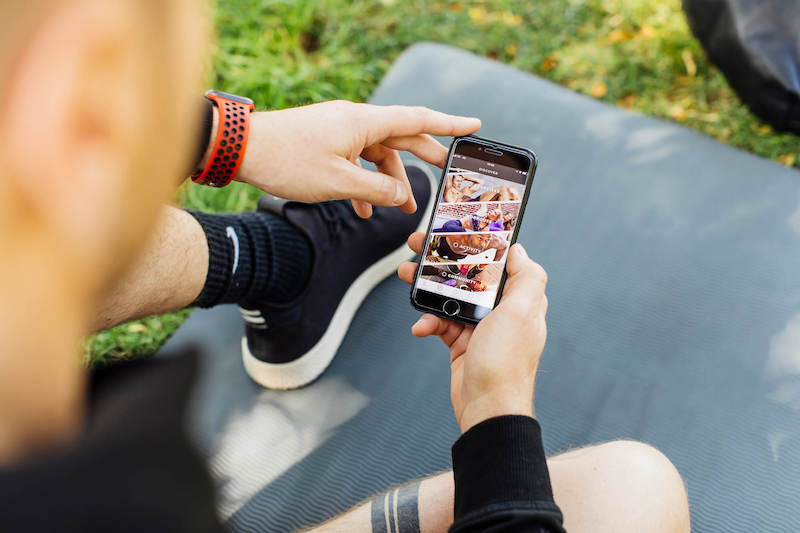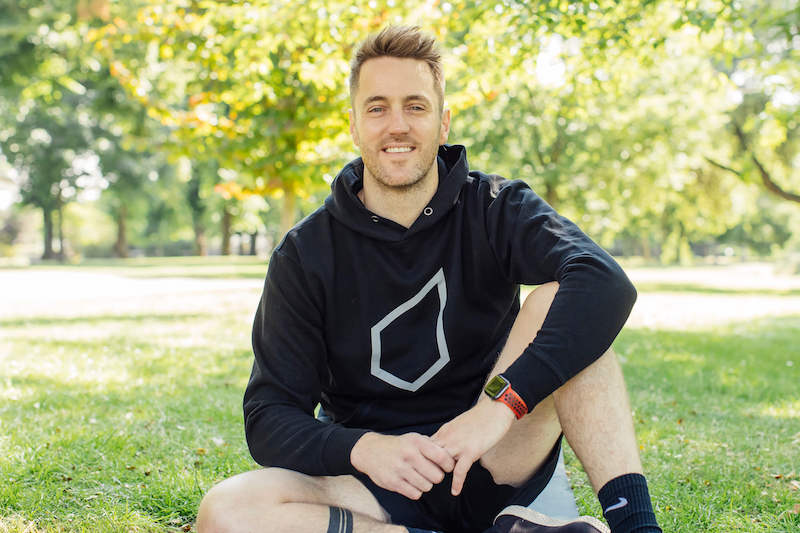Startup founders have infamously unpredictable daily schedules as they work to establish and grow their businesses. What does such an entrepreneur’s weekly, daily, or even hourly routine look like when sometimes there aren’t enough hours in a day? In the Startup Diaries, founders walk us through a week in their lives and show what it really takes to get a fledgling business off the ground.
There’s a reason Bruce Mackintosh, founder of the subscription-based fitness app SoSweat, has the word “relentless” tattooed on his left arm. “I always need more,” he explains. “It’s like, ‘Great, I’ve achieved this little thing… what’s next?’”
It’s the sort of trait that can motivate an entrepreneur and exhaust him. “This morning, for example, I was in a bad mood because I woke up and there was a three-star review in the App Store,” he says. “So now I look at myself and go, ‘Ugh, what have I done wrong?’ In reality, that reviewer is probably just difficult to please.”
Mackintosh, who has a background in coding and app development and worked as a personal trainer in college, launched his business in February 2018 with a temporary team of four and help from a personal-trainer friend. But these days, or at least until his first round of funding comes through, he’s a one-man show. “Whenever there’s something I don’t know how to do,” he says, “I just knuckle down and figure it out.” (See: relentless.)
An unexpected break came in October 2018, when an Apple representative reached out about promoting SoSweat in the App Store. “They said were looking for some good products,” Mackintosh remembers, and they recommended he make a few strategic improvements to the app before they featured it. Since then, he says, “they’ve been mentoring SoSweat into a position where they’re happy to constantly promote it.” (The app was recently touted in a “No Gym Membership Required” carousel alongside Nike, for example.)
“That was a major turning point,” says Mackintosh, a WeWork Labs member at WeWork 8 Devonshire Square in London. “We had an external source saying the app is aesthetically acceptable, it doesn’t crash, and it’s not fraudulent to the users. There was credibility bestowed by that accolade.” There was also a bump in subscribers: The app, which has 50,000 users, has seen consistent month-over-month growth ever since.
Mackintosh, who’s developing a top-secret feature for the app and finalizing his pitch deck, shares a diary of a recent workweek.

Monday
6:30 a.m. Wake up. I don’t use an alarm. I’d much rather get the rest I need; that way I’m able to perform better during the day. If I get to work a half-hour later, what difference does it make?
7 a.m. Check email. I get a daily update on various KPIs, which is actually a nice way to remember I’m on track. It’s a little jolt of “Let’s go!”
7:15 a.m. Gym. Today I do 175 burpees as part of my “365 burpee challenge,” which is to do as many burpees per day as there have been days in the year. (On January 1 you do one, on January 2 you do two, etc.) I was looking to do something outside of work that was specific and focused, but not necessarily going to take away from the business or drain me mentally.
8:30 a.m. Breakfast (scrambled eggs and bacon on a bagel).
9 a.m. Commute to work on my Xiaomi scooter. It’s such a fun way to travel—it makes me feel like a child.
10 a.m. Update social media and plow through admin tasks.
11 a.m. Monday standup at WeWork Labs. My big challenge for the week is finalizing my pitch deck.
11:30 a.m. Fix product bugs.
12:30 p.m. Work on new product feature. I don’t want to give too much information, but I’m focused on addressing motivation, which is my users’ biggest problem, and accountability is my main driver at the moment. The problem with a mobile product is that accountability is kind of disconnected. If I don’t feel like getting off the couch at 5 o’clock, I can just stay on the couch. So I need to externalize the accountability.
1:30 p.m. Lunch with the founder of BikeNav (a motorbike-navigation app), also a Labs member. Both of our products use a subscription model, so we spend time strategizing around how to bring in more subscribers and ensure that existing users continue to renew.
2 p.m. Work on pitch deck. I’m going for quite a big raise—£1.2 million. I want to build technical offerings as well as a team.
3:30 p.m. Pitch-deck roasting at WeWork Labs. Everybody presents their pitch deck, and members offer feedback: “Your font is wrong,” “That doesn’t make sense,” things like that.
6 p.m. Meet with a potential adviser. I’m looking to appoint someone who can challenge me, like, “No, Bruce, that’s bullsh*t, stop doing that.” Someone I can bounce ideas off, too.
8:15 p.m. Return to the office and catch up on email.
9 p.m. Scoot home and eat dinner. FaceTime with my wife, who’s out of town this week. She’s always incredibly supportive.
11 p.m. Listen to my Bad Blood audiobook. If I can learn something from the story, it’s that I do need to be a little bit more visionary, say to investors, “This is where the business is going to be—you’d better get on.” Again, without lying or deceiving.
11:15 p.m. Shower and go to bed.
Tuesday
8:10 a.m. Wake up and check email.
8:40 a.m. Head to the gym for today’s burpee challenge.
9:30 a.m. Breakfast smoothie with mango. I recently bought a NutriBullet, and I’m like, “Where was this my whole life?”
9:50 a.m. Scoot to the office.
10:45 a.m. Check off admin tasks.
11:30 a.m. Work on pitch video ideas. Just the word “fitness” makes VCs glaze over. So I’m thinking of shooting something that gives an understanding of the product and the core new features that are coming along. Hopefully a video can also show some of my quirks. I don’t come across as the stereotypical personal trainer that’s big and brawny, and that can actually play to my strengths.
12:30 p.m. Back to the pitch deck. I’ve gotten a lot of feedback from entrepreneurs and VCs who say, “You need to shout a little more.” For example, I have an MBA—I didn’t have that in the pitch.
2:30 p.m. Lunch.
4:15 p.m. Back to the pitch deck.
6:30 p.m. Stop home, then scoot to gymnastics. When I was younger, I couldn’t do a flip into a pool or on a trampoline. One day I thought, let me go try. And it’s been great.
8:45–10:30 p.m. Shower, dinner, bed.
Wednesday
7:15 a.m. Wake up and check email.
7:45 a.m. Burpee challenge.
8:45 a.m. Get ready for the day and scoot to the office while finishing up Bad Blood.
9:30 a.m. Catch up with other entrepreneurs at WeWork Labs. Working on your own can be very difficult. In traditional jobs, you have a set of tasks and responsibilities, and at the end of the year, you get reviewed. Have you done well? Entrepreneurs don’t have that, especially when they’re starting out. I find it incredibly hard to keep going in the face of no approval or positive feedback. The WeWork community helps with that.

10:15 a.m. Social media and admin.
10:30 a.m. Back to the pitch deck.
1:15 p.m. Lunch.
1:30–3:30 p.m. Emails and pitch deck.
3:30 p.m. Work on the new product feature.
6 p.m. Weightlifting class. You can’t exactly be a fitness-brand founder and not be fit yourself. Thankfully, I love working out.
8:30 p.m. Burritos for dinner.
10:30 p.m. Watch TV. I don’t watch programs during the week; I go to YouTube on my Apple TV. It’s mindless—a way to decompress and slow down.
11 p.m. Bed.
Thursday
6:15 a.m. Wake up, check KPIs, and make a smoothie.
8 a.m. Scoot to the office while listening to a new audiobook, Start With Why, by Simon Sinek. The takeaway so far: Don’t start with what you do, as in “I have a fitness product,” but start with why you do it, as in, “I’m solving the fitness-motivation problem.”
9:30 a.m. Pitch deck.
11 a.m. Call with potential adviser. Haven’t found the right person yet, but I’m getting there.
12:30 p.m. Group lunch hosted by WeWork.
2:40 p.m. Another pitch-deck roasting, this time with a VC.
4 p.m. Tinker with the pitch deck some more.
6:30 p.m. WeWork’s Pride-themed quiz night hosted by a drag queen. So much fun!
9:15 p.m. Scoot home.
9:45 p.m. Go to the gym for sit-ups and burpees. It’s been interesting to see the parallels between how friends and family have reacted to the Burpee Challenge and how they’ve reacted to my business. In the beginning, for both, everybody was like, “You’re crazy,” and telling me why it can’t be done. But as I’ve progressed, those naysayers have started turning positive.
10:30 p.m. Snacks and TV.
11:30 p.m. Shower and bed.
Friday
7:30 a.m. Wake up and have tea in bed.
8:40 a.m. Scoot to the office while listening to Start With Why. I like that Sinek uses real-world examples. For instance, Steve Jobs didn’t tell his audience about how the iPod is a 32G hard drive with an LCD screen. He told them that it’s 1,000 songs in their pocket.
9:30 a.m. Social media and admin.
10 a.m.–6 p.m. Work on new product feature for the rest of the day, breaking only for lunch and coffee.
7 p.m. Go to the gym for a workout (and burpees, of course).
9:30 p.m. Dinner and TV.
10:45 p.m. Shower and in bed before 11 on a Friday. I’ll happily go out, but it tends not to be my choice. It’s not my thing—I don’t drink, I don’t smoke. I think about how easy it is for people to go out every Friday night and have drinks, because it’s something that they enjoy, and I wonder: How can I bring that urgency to my product? Because I don’t necessarily do the biggest workout every single day, but I definitely do it, and I always feel good afterwards. How can I make everybody feel that? If I solve that problem, I’ll be a billionaire many times over.







